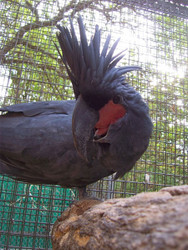Easy Parrot Training Capture a Behaviour by Barbara Heidenreich
Posted by Capture a behaviour, Parrot training on 20/3/2025
Barbara Heidenreich explains how to capture a behaviour.
If I had the chance I would love to train a Palm Cockatoo to present this behaviour on cue. To train a behaviour like this we use a process called capturing.
And it is very much like it sounds. We try to catch the animal in the act of doing what it is we want and reward in that exact moment.
Behaviour
To capture a behaviour we try to create an environment in which the bird is very likely to present the behaviour.

For example, if I were training a Palm Cockatoo I would want to have a hollowed log set up and lots of sticks.
I might ask the bird to perch on the log and offer him a stick. And then I would wait and see if maybe he would be inspired to drum.
The moment he hits the log with the stick, I would give him a treat, head scratch or something else I know he enjoys. This teaches the Cockatoo that drumming is very worthwhile. It causes humans to dispense goodies.
Drumming
If the bird really likes what I have been giving him, he will keep drumming. When this starts to happens I can an insert a cue just before I think he is about to whack the log with the stick. Pretty soon my Cockatoo will learn to drum whenever I give the cue.
This process is a little different from other ways that we train behaviours. Instead of teaching a bird how to do something by breaking it down into tiny steps, we just set up the right environment and wait for the behaviour to be presented.
While not everyone has the chance to work with a Palm Cockatoo, capturing behaviour is something you can do with any Parrot in your life. There are many behaviours our Parrots just ?do? throughout the day that are very pleasant to put on cue.
For example maybe you have a Cockatiel that whistles a pretty song over and over. You could easily capture the song by offering a bite of millet spray whenever he whistles the tune. This is the same strategy you would use if you Parrots talks or sings.
Feathers
Some people really like it when their Cockatoo raises his crest feathers or their Parrot stretches their wing out over a leg while balancing on the other. These moves can also be captured.
One of the challenges with capturing behaviour is you may not get a lot of repetition of the behaviour at first. You might have to wait a few minutes, hour or days for your next opportunity to catch your bird in the act of doing what behaviour you want.
That?s OK. Your bird can still learn what it is you want him to do. It just may take a few days for him to catch on to the idea.
Spend some time watching your bird and makes notes of all the different things your Parrot does that you could capture and put on cue. Pick one behaviour to capture first.
Cue
Once that behaviour is on cue, move onto the next behaviour. You will find once your Parrot learns one behaviour via capturing, he will quickly figure out how this game works. Pretty soon your bird will know an impressive list of behaviours.
Get more advice on training and behaviour here.
Barbara Heidenreich has been a professional animal trainer since 1990. Her company Good Bird Inc ( www.GoodBirdInc.com) provides Parrot training DVDs, books and workshops. She has been a featured speaker in twenty countries and has been published in nine languages. Barbara also consults on animal training in zoos.
Barbara Heidenreich
For more information on how to train your Parrot visit Good Bird Inc
Barbara's Force Free Animal Training www.BarbarasFFAT.com
Copyright 2014 First appears in Fledglings Magazine by The Parrot Society of Australia

